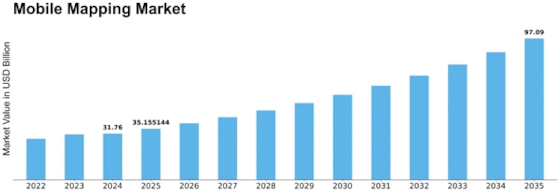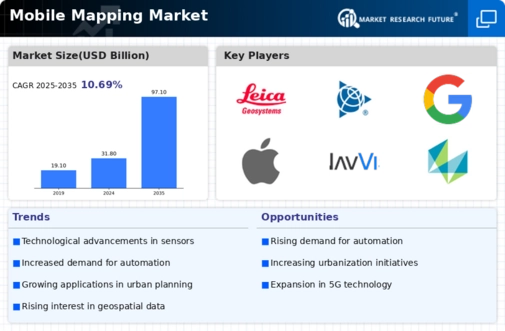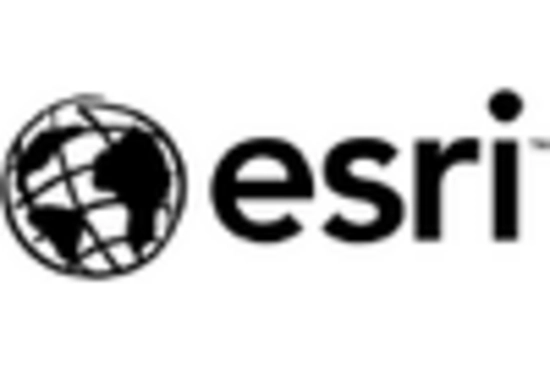-
EXECUTIVE SUMMARY
-
GLOBAL MOBILE
-
MAPPING MARKET, BY COMPONENT 21
-
GLOBAL MOBILE MAPPING MARKET, BY SOLUTION 22
-
GLOBAL MOBILE
-
MAPPING MARKET, BY APPLICATION 23
-
GLOBAL MOBILE MAPPING MARKET, BY USER TYPE 24
-
GLOBAL MOBILE
-
MAPPING MARKET, BY END USER 25
-
GLOBAL MOBILE MAPPING MARKET, BY REGION 26
-
MARKET INTRODUCTION
-
DEFINITION
-
27
-
2.2
-
SCOPE OF THE STUDY 27
-
RESEARCH OBJECTIVE 27
-
MARKET STRUCTURE 28
-
RESEARCH METHODOLOGY
-
RESEARCH PROCESS 29
-
PRIMARY RESEARCH 30
-
SECONDARY RESEARCH 31
-
MARKET SIZE ESTIMATION 32
-
FORECAST MODEL
-
33
-
3.6
-
LIST OF ASSUMPTIONS 34
-
MARKET DYNAMICS
-
INTRODUCTION 35
-
DRIVERS 36
- INCREASING AWARENESS REGARDING INVENTORY AND
- INCREASING PENETRATION OF MOBILE MAPPING DEVICES AND INFRASTRUCTURAL
-
ASSET MANAGEMENT 36
-
DEVELOPMENT OF TELECOMMUNICATION NETWORKS 36
-
RESTRAINT 37
- SYSTEM LIMITATIONS 37
-
OPPORTUNITY 37
- INTEGRATION
-
OF MOBILE MAPPING SYSTEMS WITH WEARABLE DEVICES 37
-
CHALLENGE 38
- CONCERNS RELATED TO LOCATION ACCURACY AND DATA
- USE OF UNMANNED AERIAL VEHICLES (UAV) FOR MOBILE
- OFFERINGS BY IT ENTERPRISES 39
- IMPACT ON SUPPLY CHAINS 39
- IMPACT ON DEMAND
-
QUALITY 38
-
4.6
-
MARKET TRENDS 38
-
4.6.1
-
AUGMENTED REALITY IN MOBILE MAPPING 38
-
MAPPING 38
-
4.7
-
THE IMPACT OF COVID-19 39
-
OF INDOOR MAPPING 39
-
MARKET FACTOR ANALYSIS
-
SUPPLY CHAIN ANALYTICS 40
- RAW MATERIAL SUPPLIERS
- SOFTWARE DEVELOPERS 41
- END USERS 41
-
40
-
5.1.2
-
MOBILE MAPPING COMPONENT PROVIDERS 40
-
PORTER’S
- THREAT OF NEW ENTRANTS 42
- BARGAINING POWER OF SUPPLIERS 42
- BARGAINING
- THREAT OF SUBSTITUTES 42
- INTENSITY OF RIVALRY 42
-
FIVE FORCES MODEL 41
-
POWER OF BUYERS 42
-
GLOBAL MOBILE MAPPING MARKET,
-
BY COMPONENT
-
6.1
-
OVERVIEW 43
-
6.1.1
-
GLOBAL MOBILE MAPPING MARKET, BY COMPONENT, 2020–2027 (USD MILLION) 43
-
44
-
6.1.3
-
HARDWARE
-
GLOBAL MOBILE MAPPING MARKET, BY HARDWARE, 2020–2027 (USD MILLION) 44
-
45
-
6.1.3.2
-
SENSORS 45
-
6.1.3.3
-
LASER SCANNERS 45
-
45
-
6.1.5
-
SERVICES 46
-
6.1.6
-
CAMERAS
-
OTHERS (POSITIONING DEVICES, STORAGE DEVICES) 45
-
SOFTWARE
-
GLOBAL MOBILE MAPPING MARKET, BY SERVICES, 2020–2027 (USD MILLION) 46
-
46
-
6.1.6.2
-
MANAGED 46
-
7
-
PROFESSIONAL
-
GLOBAL MOBILE MAPPING MARKET, BY SOLUTION
-
OVERVIEW 47
- GLOBAL MOBILE MAPPING MARKET, BY SOLUTION,
- LOCATION BASED 48
- INDOOR MAPPING 48
- ASSET MANAGEMENT 48
- 3D MAPPING 48
- OTHERS (DISASTER
-
RESPONSE SOLUTION, AND CRIME SCENE ANALYSIS) 48
-
GLOBAL MOBILE MAPPING MARKET, BY APPLICATION
-
OVERVIEW 49
- GLOBAL MOBILE
-
MAPPING MARKET, BY APPLICATION, 2020–2027 (USD MILLION) 49
-
50
-
8.1.4
-
BRIDGE PLANNING 50
-
LAND SURVEYS 50
-
AERIAL SURVEYS
-
OTHERS 50
-
GLOBAL MOBILE MAPPING MARKET, BY USER TYPE
-
OVERVIEW 51
- GLOBAL MOBILE
-
MAPPING MARKET, BY USER TYPE, 2020–2027 (USD MILLION) 51
-
INDIVIDUALS 52
-
ENTERPRISES
-
52
-
10
-
GLOBAL MOBILE MAPPING MARKET, BY END-USER
-
OVERVIEW 53
- GLOBAL MOBILE MAPPING MARKET, BY END-USER,
- REAL ESTATE & CONSTRUCTION 54
- AVIATION &
- MANUFACTURING 55
- AGRICULTURE 55
- ENERGY & POWER 55
- MARINE TRANSPORT 56
- HEALTHCARE
- OTHERS 56
-
AEROSPACE 54
-
10.1.4
-
MINING 55
-
10.1.5
-
IT & TELECOM 55
-
56
-
10.1.11
-
MEDIA & ENTERTAINMENT 56
-
GLOBAL MOBILE MAPPING MARKET, BY REGION
-
OVERVIEW 57
- GLOBAL MOBILE
-
MAPPING MARKET, BY REGION, 2020–2027 (USD MILLION) 58
-
NORTH AMERICA 59
- NORTH AMERICA:
-
MOBILE MAPPING MARKET, BY COUNTRY, 2020–2027 (USD MILLION) 59
-
NORTH AMERICA:
-
MOBILE MAPPING MARKET, BY COMPONENT, 2020–2027 (USD MILLION) 60
-
NORTH AMERICA
-
MOBILE MAPPING MARKET, BY HARDWARE, 2020–2027 (USD MILLION) 61
-
NORTH AMERICA
-
MOBILE MAPPING MARKET, BY SERVICE, 2020–2027 (USD MILLION) 62
-
NORTH AMERICA
-
MOBILE MAPPING MARKET, BY SOLUTION, 2020–2027 (USD MILLION) 63
-
NORTH AMERICA
-
MOBILE MAPPING MARKET, BY APPLICATION, 2020–2027 (USD MILLION) 64
-
NORTH AMERICA
-
MOBILE MAPPING MARKET, BY USER TYPE, 2020–2027 (USD MILLION) 65
-
NORTH AMERICA
-
MOBILE MAPPING MARKET, BY END-USER, 2020–2027 (USD MILLION) 66
-
70
-
11.2.11
-
MEXICO 73
-
11.3
-
EUROPE 76
-
11.3.1
-
US 67
-
CANADA
-
EUROPE: MOBILE MAPPING MARKET, BY COUNTRY, 2020–2027 (USD MILLION) 76
-
EUROPE:
-
MOBILE MAPPING MARKET, BY COMPONENT, 2020–2027 (USD MILLION) 77
-
EUROPE:
-
MOBILE MAPPING MARKET, BY HARDWARE, 2020–2027 (USD MILLION) 78
-
EUROPE: MOBILE
-
MAPPING MARKET, BY SERVICE, 2020–2027 (USD MILLION) 79
-
EUROPE MOBILE MAPPING
-
MARKET, BY SOLUTION, 2020–2027 (USD MILLION) 80
-
(USD MILLION) 82
-
11.3.8
-
EUROPE MOBILE MAPPING MARKET, BY APPLICATION,
-
EUROPE MOBILE MAPPING MARKET, BY USER TYPE, 2020–2027
-
EUROPE MOBILE MAPPING MARKET, BY END-USER, 2020–2027 (USD MILLION) 83
-
87
-
11.3.11
-
FRANCE 90
-
11.3.12
-
THE NETHERLANDS 93
-
UK 84
-
GERMANY
-
SPAIN 96
-
ITALY 99
-
REST OF EUROPE 102
-
ASIA-PACIFIC 105
- ASIA-PACIFIC:
-
MOBILE MAPPING MARKET, BY COUNTRY, 2020–2027 (USD MILLION) 105
-
ASIA-PACIFIC:
-
MOBILE MAPPING MARKET, BY COMPONENT, 2020–2027 (USD MILLION) 106
-
ASIA-PACIFIC:
-
MOBILE MAPPING MARKET, BY HARDWARE, 2020–2027 (USD MILLION) 107
-
ASIA-PACIFIC:
-
MOBILE MAPPING MARKET, BY SERVICE, 2020–2027 (USD MILLION) 108
-
ASIA-PACIFIC MOBILE
-
MAPPING MARKET, BY SOLUTION, 2020–2027 (USD MILLION) 109
-
ASIA-PACIFIC MOBILE MAPPING
-
MARKET, BY APPLICATION, 2020–2027 (USD MILLION) 110
-
ASIA-PACIFIC MOBILE MAPPING
-
MARKET, BY USER TYPE, 2020–2027 (USD MILLION) 111
-
ASIA-PACIFIC MOBILE MAPPING
-
MARKET, BY END-USER, 2020–2027 (USD MILLION) 112
-
125
-
11.5.1
-
CHINA 113
-
JAPAN 116
-
INDIA 119
-
REST OF ASIA-PACIFIC 122
-
REST OF THE WORLD
-
REST OF THE WORLD: MOBILE MAPPING MARKET, BY COUNTRY, 2020–2027 (USD MILLION)
-
125
-
11.5.2
-
REST OF THE WORLD: MOBILE MAPPING MARKET, BY COMPONENT, 2020–2027 (USD MILLION)
-
126
-
11.5.3
-
REST OF THE WORLD: MOBILE MAPPING MARKET, BY HARDWARE, 2020–2027 (USD MILLION)
-
127
-
11.5.4
-
REST OF THE WORLD: MOBILE MAPPING MARKET, BY SERVICE, 2020–2027 (USD MILLION)
-
128
-
11.5.5
-
REST OF THE WORLD MOBILE MAPPING MARKET, BY SOLUTION, 2020–2027 (USD MILLION)
-
129
-
11.5.6
-
REST OF THE WORLD MOBILE MAPPING MARKET, BY APPLICATION, 2020–2027 (USD MILLION)
-
130
-
11.5.7
-
REST OF THE WORLD MOBILE MAPPING MARKET, BY USER TYPE, 2020–2027 (USD MILLION)
-
131
-
11.5.8
-
REST OF THE WORLD MOBILE MAPPING MARKET, BY END-USER, 2020–2027 (USD MILLION)
-
132
-
11.5.9
-
THE MIDDLE EAST & AFRICA 133
-
SOUTH AMERICA 136
-
COMPETITIVE LANDSCAPE
-
COMPETITIVE OVERVIEW 139
- VENDOR SHARE
-
ANALYSIS 139
-
12.2
-
COMPETITOR DASHBOARD 141
-
COMPETITOR DASHBOARD 142
-
KEY DEVELOPMENTS & GROWTH STRATEGIES 143
- PRODUCT
-
DEVELOPMENT 143
-
12.4.2
-
MERGERS, ACQUISITIONS, AND PARTNERSHIPS 144
-
COMPANY PROFILES
-
TRIMBLE INC. 146
- COMPANY OVERVIEW 146
- FINANCIAL OVERVIEW 147
- PRODUCTS/SOLUTIONS/SERVICES
- SWOT ANALYSIS 148
- KEY STRATEGIES 149
-
OFFERED 147
-
13.1.4
-
KEY DEVELOPMENTS 148
-
HEXAGON AB 150
- COMPANY
- PRODUCTS/SOLUTIONS/SERVICES OFFERED 151
- KEY DEVELOPMENTS 151
- SWOT ANALYSIS
-
OVERVIEW 150
-
13.2.2
-
FINANCIAL OVERVIEW 150
-
152
-
13.2.6
-
KEY STRATEGIES 152
-
GOOGLE INC. 153
- COMPANY OVERVIEW 153
- FINANCIAL OVERVIEW 153
- PRODUCTS/SOLUTIONS/SERVICES
- SWOT ANALYSIS 154
- KEY STRATEGIES 155
-
OFFERED 154
-
13.3.4
-
KEY DEVELOPMENTS 154
-
APPLE INC. 156
- COMPANY
- PRODUCTS/SOLUTIONS/SERVICES OFFERED 157
- KEY DEVELOPMENTS 157
- SWOT ANALYSIS
-
OVERVIEW 156
-
13.4.2
-
FINANCIAL OVERVIEW 156
-
157
-
13.4.6
-
KEY STRATEGIES 158
-
MITSUBISHI ELECTRIC CORPORATION 159
- COMPANY OVERVIEW 159
- FINANCIAL OVERVIEW 159
- PRODUCTS/SOLUTIONS/SERVICES
- SWOT ANALYSIS 160
- KEY STRATEGIES 161
-
OFFERED 160
-
13.5.4
-
KEY DEVELOPMENTS 160
-
MICROSOFT CORPORATION 162
- COMPANY
- PRODUCTS/SOLUTIONS/SERVICES OFFERED 163
- KEY DEVELOPMENTS 163
- SWOT ANALYSIS
-
OVERVIEW 162
-
13.6.2
-
FINANCIAL OVERVIEW 162
-
164
-
13.6.6
-
KEY STRATEGIES 164
-
TELEFONAKTIEBOLAGET LM ERICSSON 165
- COMPANY OVERVIEW 165
- FINANCIAL OVERVIEW 165
- PRODUCTS/SOLUTIONS/SERVICES
- SWOT ANALYSIS 166
- KEY STRATEGIES 166
-
OFFERED 166
-
13.7.4
-
KEY DEVELOPMENTS 166
-
TOPCON CORPORATION 167
- COMPANY
- PRODUCTS/SOLUTIONS/SERVICES OFFERED 168
- KEY DEVELOPMENTS 168
- SWOT ANALYSIS
-
OVERVIEW 167
-
13.8.2
-
FINANCIAL OVERVIEW 167
-
168
-
13.8.6
-
KEY STRATEGIES 168
-
TOMTOM INTERNATIONAL BV 169
- COMPANY OVERVIEW 169
- FINANCIAL OVERVIEW 169
- PRODUCTS/SOLUTIONS/SERVICES
- SWOT ANALYSIS 170
- KEY STRATEGIES 171
-
OFFERED 170
-
13.9.4
-
KEY DEVELOPMENTS 170
-
FARCO TECHNOLOGIES 172
- COMPANY
- PRODUCTS/SOLUTIONS/SERVICES OFFERED 173
- KEY DEVELOPMENTS 173
- SWOT ANALYSIS
-
OVERVIEW 172
-
13.10.2
-
FINANCIAL OVERVIEW 172
-
173
-
13.10.6
-
KEY STRATEGIES 173
-
PASCO CORPORATION 174
- COMPANY OVERVIEW 174
- FINANCIAL OVERVIEW 174
- PRODUCTS/SOLUTIONS/SERVICES
- KEY STRATEGIES 174
-
OFFERED 174
-
13.11.4
-
KEY DEVELOPMENTS 174
-
HURON GEOMATICS INC. 175
- COMPANY OVERVIEW 175
- FINANCIAL
- KEY DEVELOPMENTS 175
- KEY STRATEGIES 175
-
OVERVIEW 175
-
13.12.3
-
PRODUCTS/SOLUTIONS/SERVICES OFFERED 175
-
IGI MBH 176
- COMPANY
- PRODUCTS/SOLUTIONS/SERVICES OFFERED 176
- KEY DEVELOPMENTS 176
- KEY STRATEGIES
- FINANCIAL OVERVIEW 177
- PRODUCTS/SOLUTIONS/SERVICES OFFERED 177
- KEY DEVELOPMENTS
- FINANCIAL OVERVIEW 178
- PRODUCTS/SOLUTIONS/SERVICES OFFERED 178
- KEY DEVELOPMENTS
-
OVERVIEW 176
-
13.13.2
-
FINANCIAL OVERVIEW 176
-
176
-
13.14
-
HYPER TECH 177
-
13.14.1
-
COMPANY OVERVIEW 177
-
177
-
13.15
-
GEXCEL SRL 178
-
13.15.1
-
COMPANY OVERVIEW 178
-
179
-
13.15.5
-
KEY STRATEGIES 179
-
THE SANBORN MAP COMPANY INC. 180
- COMPANY OVERVIEW 180
- FINANCIAL OVERVIEW 180
- PRODUCTS/SOLUTIONS/SERVICES
- KEY STRATEGIES 181
-
OFFERED 180
-
13.16.4
-
KEY DEVELOPMENTS 180
-
3D LASER MAPPING (GEOSLAM) 182
- COMPANY OVERVIEW
- PRODUCTS/SOLUTIONS/SERVICES OFFERED 182
- KEY DEVELOPMENTS 182
- KEY STRATEGIES
- FINANCIAL OVERVIEW 183
- PRODUCTS/SOLUTIONS/SERVICES OFFERED 183
- KEY DEVELOPMENTS
-
182
-
13.17.2
-
FINANCIAL OVERVIEW 182
-
182
-
13.18
-
NAVVIS 183
-
13.18.1
-
COMPANY OVERVIEW 183
-
183
-
13.18.5
-
KEY STRATEGIES 184
-
NGC AEROSPACE LTD 185
- COMPANY OVERVIEW 185
- FINANCIAL OVERVIEW 185
- PRODUCTS/SOLUTIONS/SERVICES
- KEY STRATEGIES 185
-
OFFERED 185
-
13.19.4
-
KEY DEVELOPMENTS 185
-
LIST OF TABLES
-
PRIMARY INTERVIEWS 30
-
LIST OF ASSUMPTIONS 34
-
GLOBAL
-
MOBILE MAPPING MARKET, BY COMPONENT, 2020–2027 (USD MILLION) 43










Leave a Comment